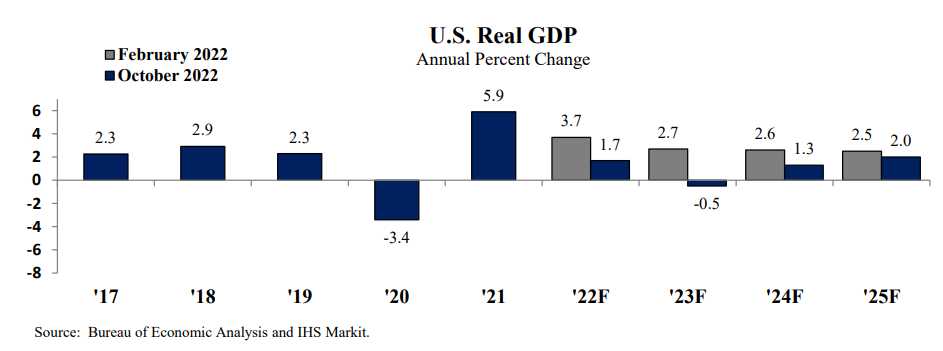While the state of Minnesota’s revenues have continued to come in better than expected, more serious economic challenges are expected ahead, including a recession starting this fall, according to the October Revenue and Economic Update from Minnesota Management and Budget (MMB). Ever since the state released its comprehensive budget forecast in February, forecasters have been ratcheting back their expectations for future economic growth, but this is the first time we’ve seen them include a recession in their economic projections.
Some of the top takeaways from the Update include:
1. Nationally, a near-term recession is predicted. Forecasters now predict a recession starting this fall and lasting until the middle of 2023. Russia’s invasion of Ukraine and supply chain challenges continue to impact the economy. The recession is also anticipated in part due to the Federal Reserve’s policy response to ongoing high inflation. Looking further into the future, national economic growth is expected to remain low, staying below 2 percent through 2025.

2. Minnesota revenues for the beginning of Fiscal Year 2023 came in higher compared to the February forecast. Revenues for July through September (the first quarter of FY 2023) came in $289 million, or 4.3 percent, higher than February Forecast projections. Sales and corporate taxes were the largest sources of this increase in revenues. However, the forecast also notes that upcoming income tax revenues for FY 2023 are expected to be lower than earlier predicted.
3. Official unemployment rate is low…for now. In September, the national unemployment rate was 3.5 percent, which brings the overall unemployment rate back to a pre-pandemic level. However, with a recession now included in the baseline economic projection, forecasters expect the U.S. unemployment rate to rise and reach 6 percent late next year.
What does this mean for the state’s budget surplus?
In the upcoming 2023 Legislative Session, policymakers must pass the state’s next two-year budget (for FY 2024-25). The October update is our last glimpse of the state’s revenue and economic picture before the more comprehensive November Budget and Economic Forecast comes out in early December.
Economic slowdowns generally have two effects on state budget projections: lower revenues; and higher spending for services that automatically respond to a greater number of folks in need. The result can be smaller budget surpluses or even a budget deficit.
When policymakers come back into session in January, they’ll look to what the Forecast predicts for the final seven months of FY 2022-23 as well as for FY 2024-25 to get a sense of what’s available as they craft the new state budget.
The state ended the 2022 Legislative Session in May with a $7.0 billion surplus projected for FY 2022-23. Much of these dollars are already in the state’s bank account so to speak, and were bolstered further when revenues for FY 2022 came in even higher than expected in the last budget forecast. Even taking into account a three-quarter recession falling in FY 2023 and other factors, a significant projected surplus, particularly for FY 2022-23, still seems likely in the November forecast.
It will be essential that policymakers distinguish between a short-term bubble and the resources available on an ongoing basis, and keep their eyes on the goal of building a stronger, more equitable future in which every Minnesotan can thrive.
Minnesotans have gone through a lot in the past two and a half years, and those experiences – and the voices of Minnesotans themselves – have shone a bright light on the income, racial, and geographic inequities in our state.
We know from past experience that recessions often impact the most vulnerable in our economy – low-income and Black, Indigenous, and other People of Color (BIPOC) Minnesotans. These are the same folks who have been disproportionately harmed by the ongoing COVID pandemic.
The last several years have also shown us that when policymakers make bold policy choices, we can ensure that folks have what they need to get through tough times.
We’ve got some resources in the bank account, but also some struggles ahead. Minnesota policymakers need to keep our state moving forward by making strong investments in affordable child care, health care, good schools, transit, and more, to address the real challenges that Minnesotans are facing and dismantle the barriers that keep too many Minnesotans from taking part in our state’s prosperity.
